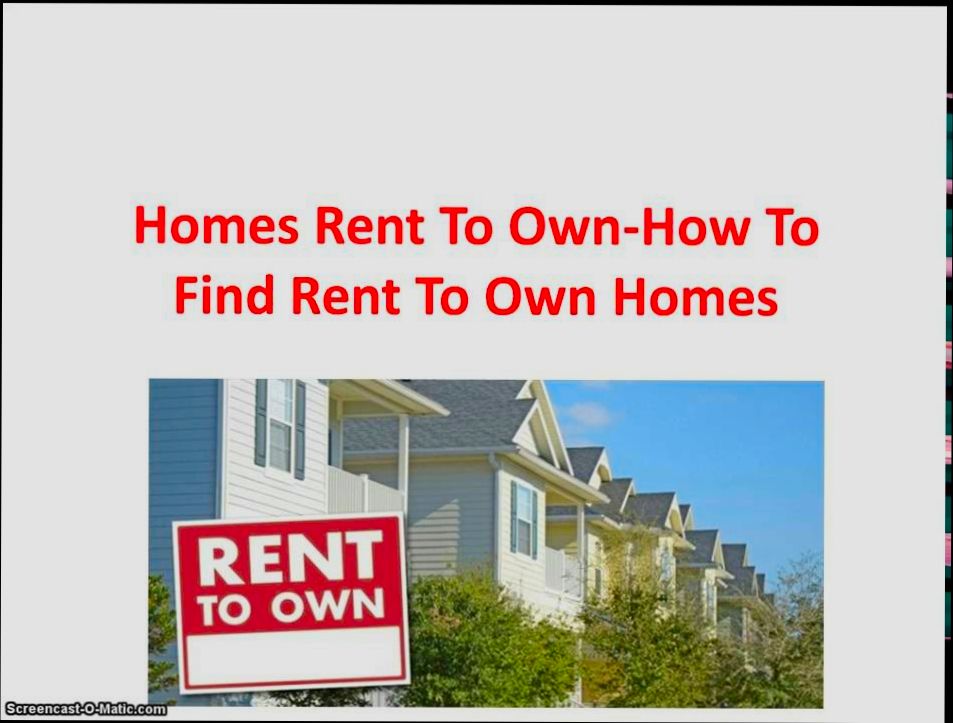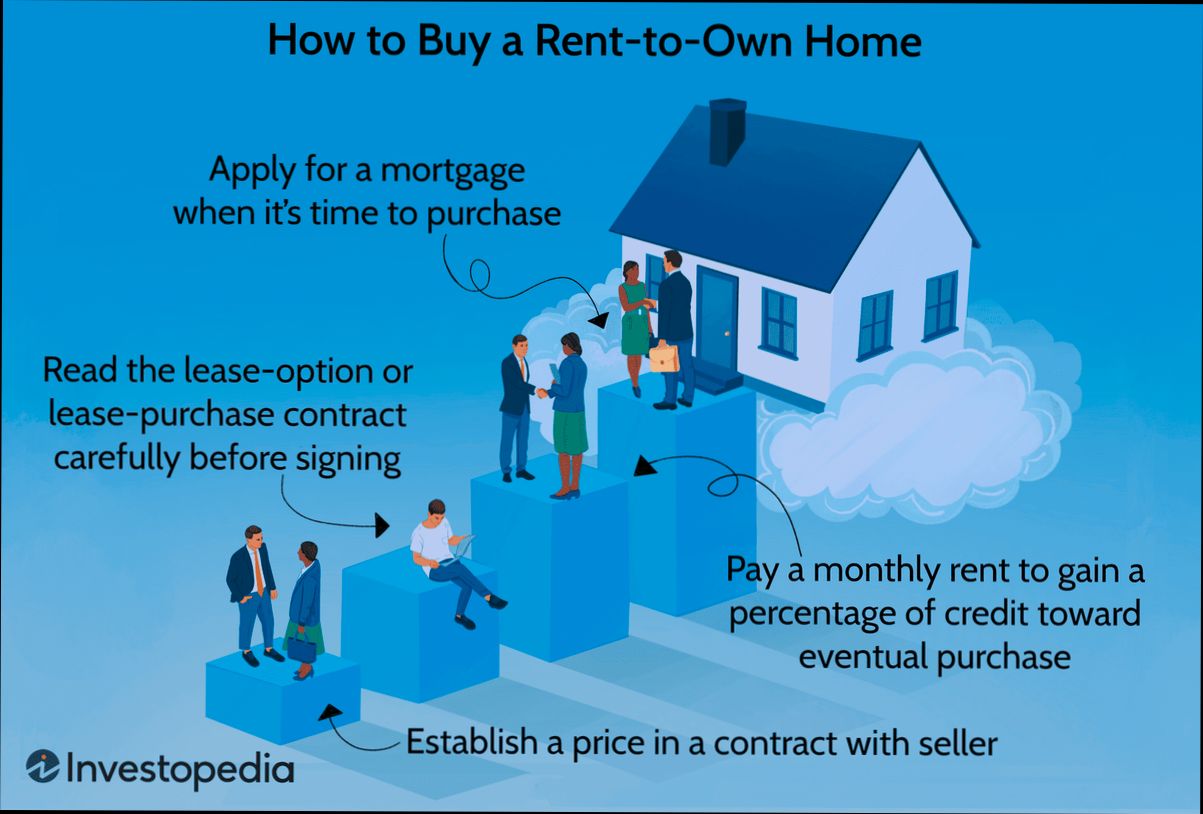How to Find Rent to Own Homes can seem like navigating a maze, especially with the housing market cycling through ups and downs. Did you know that according to a recent study, about 30% of all renters in the U.S. are actively considering rent-to-own options? It’s not just a passing trend; more folks are realizing that renting doesn’t have to be a lifelong commitment. For example, in neighborhoods like Riverside, California, various properties are popping up with rent-to-own agreements that let you live in your dream home while building equity.
If you’re feeling a bit adventurous, you might start your journey by checking local listings in real estate websites, or even scrolling through Facebook Marketplace where people often list their properties with flexible terms. You might stumble upon a charming three-bedroom house in Atlanta that’s been in the family for generations but the owners are ready to let it go on a rent-to-own basis. These stories aren’t rare; many owners are eager to find responsible tenants who want to transition into homeowners. Digging into community forums or local real estate meet-ups can also unveil hidden gems that you won’t find on the usual platforms. This method not only expands your options but connects you directly with people who have firsthand experiences to share.

Understanding the Rent to Own Concept
The rent to own concept offers a unique pathway to homeownership that blends renting with the opportunity to purchase the property in the future. By understanding this model, you can make informed decisions about whether this approach suits your financial situation and housing goals.
What is Rent to Own?
Rent to own agreements involve two primary components:
1. Lease Agreement: You initially rent a property, with a pre-determined lease period, typically between one to three years.
2. Purchase Option: At the end of the lease, you hold the option to buy the home at a previously agreed-upon price.
This model can be particularly attractive for individuals who are not ready to purchase outright due to limited savings or credit challenges.
Key Characteristics of Rent to Own
- Rent Credits: Often, a portion of your monthly rent may be credited toward the eventual down payment. For instance, some agreements allocate up to 30% of each payment as rent credits toward the purchase price.
- Purchase Price Lock: The purchase price is typically locked in at the beginning of the lease, protecting you from market fluctuations.
- Flexibility: You have the flexibility to walk away at the end of the lease if you decide not to buy, though you may forfeit any accumulated rent credits.
Rent to Own Dynamics
| Feature | Traditional Lease | Rent to Own |
|---|---|---|
| Purchase Option | No | Yes |
| Rent Credits | No | Yes |
| Price Lock | No | Yes |
| Lease Duration | Generally Fixed | 1 to 3 Years |
| Ownership Potential | No | Yes |
Real-World Examples
- Case Study 1: Emily wanted to buy a home but struggled to save for a large down payment. She found a rent to own agreement where her monthly rent included a $300 credit toward her down payment. After two years of renting, she was able to use $7,200 toward her home purchase.
- Case Study 2: John was concerned about market volatility while looking to buy. He entered a rent to own contract that locked in the home price at $250,000 for three years. When the market increased, John had the advantage of buying at the lower price, which offered substantial savings.
Practical Implications for Readers
Understanding the rent to own concept not only equips you with potential financial strategies but also builds confidence in your path to homeownership. Here are some considerations:
- Assess Contract Terms: Always read the agreement carefully, particularly the conditions surrounding the purchase option.
- Conduct Market Research: Evaluate property values in the area to ensure the locked-in purchase price remains favorable.
- Financial Planning: Factor in the costs of maintenance and property taxes in your budget, as these expenses may fall to you during the lease period.
Additional Points to Note
- Rent to own properties often require a larger upfront fee than traditional renting arrangements. This is often a non-refundable option fee.
- Be aware that not all rent to own opportunities guarantee a successful purchase; specific conditions might lead to forfeiting your investment. Always consult legal advice when entering such agreements.

Exploring Local Market Trends and Statistics
Diving into local market trends and statistics is crucial for anyone interested in finding rent-to-own homes. Understanding how the local market operates can help you make informed decisions about your future home. Let’s unpack some valuable data and insights to guide your search.
Key Market Data
Exploring the landscape of rent-to-own homes involves analyzing various market statistics:
- Average Rental Prices: In many metropolitan areas, rental prices have increased by over 15% year-on-year. Familiarizing yourself with these trends can provide context to what you should expect when negotiating a rent-to-own agreement.
- Home Price Fluctuations: Nationally, home prices have experienced a 7% rise, but local markets can vary widely. For instance, in urban markets like San Francisco, prices skyrocketed by 20%, making rent-to-own options more attractive to potential buyers who wish to lock in prices now.
- Vacancy Rates: In some regions, current vacancy rates sit below 3%, indicating a tight rental market. This scarcity can signal more competition for available rent-to-own properties, affecting your negotiation leverage.
| Market Area | Average Rental Price | Year-on-Year Increase | Vacancy Rate |
|---|---|---|---|
| San Francisco | $3,500 | +20% | 1.5% |
| Austin | $2,200 | +13% | 2.8% |
| Pittsburgh | $1,500 | +10% | 4.0% |
| Atlanta | $2,000 | +15% | 3.1% |
Real-World Examples
In researching local markets, I discovered notable success stories that underline the importance of understanding trends:
- Case Study: Chicago: One family leveraged the rising rental market, where prices had jumped by 16% over the previous year. They found a rent-to-own home in a neighborhood that historically saw 5% annual appreciation—turning their rental agreement into a valuable investment.
- Case Study: Miami: A couple looking at rent-to-own options in Miami capitalized on a 12% increase in rental prices. Their awareness of declining vacancy rates led them to secure a home before it was off the market, illustrating how being informed gives buyers an edge.
Practical Implications
The insights gathered from local market trends directly affect your search for rent-to-own homes. When you analyze data specific to your area, consider the following actions:
- Research Neighborhood Trends: Track how rental and home prices fluctuate in your desired neighborhoods.
- Assess Local Inventory: Pay close attention to vacancy rates, as lower rates mean fewer available properties, impacting your choices and timelines.
- Monitor Seasonal Changes: Understand how different times of the year can affect the availability and pricing of rent-to-own agreements in your market.
Stay alert to changes in your specific market. If rental prices continue to rise, acting swiftly can help you secure favorable terms on a rent-to-own property. Tracking local statistics not only empowers your decisions but also helps you anticipate market movements that might affect your options.

Identifying Rent to Own Property Listings
Finding rent to own property listings can be a rewarding journey toward homeownership if you know where and how to look. In this section, I’ll share actionable tips and insights that can help you effectively identify potential rent to own homes in your desired area.
Key Resources for Rent to Own Listings
1. Online Platforms: Utilize websites that specialize in rent-to-own listings. Some popular platforms include:
- Craigslist
- Zillow
- RentToOwnLabs
- HousingList
2. Local Real Estate Agents: Partner with local real estate agents who have experience in rent-to-own properties. They can provide you with exclusive listings that may not be readily available online.
3. Social Media and Community Groups: Join local Facebook groups or community forums where homeowners might advertise rent-to-own opportunities directly.
4. Neighborhood Driving Tours: Physically explore neighborhoods you’re interested in. Look for “For Rent” signs that may also tout rent-to-own options.
Comparative Analysis of Listing Sources
| Source | Ease of Access | Variety of Listings | Accuracy of Info | Market Coverage |
|---|---|---|---|---|
| Online Platforms | High | Moderate | Variable | Nationwide |
| Local Real Estate Agents | Moderate | High | High | Localized |
| Social Media Groups | Moderate | Variable | Variable | Community Specific |
| Neighborhood Tours | Low | Low | High | Hyper-local |
Real-World Case Study
Consider Emily, a first-time homebuyer who discovered a rent-to-own property through Zillow. Although the listing initially seemed too good to be true, a conversation with the seller revealed a hidden gem in her desired neighborhood. With the help of a local agent, she verified that the terms of the lease were straightforward and that the seller was motivated to find a long-term tenant who might eventually purchase the property.
Practical Implications for Identifying Listings
- Set Up Alerts: Use online platforms to set alerts for new rent-to-own listings that meet your criteria.
- Conduct Regular Searches: Make a habit of checking listings several times a week. Availability can change quickly.
- Understand Lease Terms: When you find a listing, carefully read the lease-to-own terms. Focus on details like the purchase price, lease duration, and how much of the rent goes toward the eventual down payment. This will save you headaches down the line.
Actionable Tips for Your Search
- Networking: Connect with individuals in your community who are interested in similar housing options; they may have leads on available properties.
- Research Local Regulations: Be aware of your state’s regulations regarding rent-to-own agreements, as these can impact your search process.
- Attend Open Houses: While these typically pertain to sale properties, open houses can also provide opportunities to ask about lease-to-own options.
- Prepare Your Finances: Have your credit report handy and possibly a pre-approval letter if you are considering purchasing down the line. This will make you a more attractive candidate when negotiating with landlords.
By actively engaging with various resources and methodologies, you can enhance your chances of finding the perfect rent-to-own listing tailored to your needs.

Evaluating the Benefits of Rent to Own
When navigating the path to homeownership, understanding the benefits of rent-to-own agreements can significantly inform your decision-making process. These arrangements offer a unique blend of renting and the opportunity to purchase a property, making them appealing for various circumstances. Let’s dive into the specific advantages you might encounter when evaluating rent-to-own options.
Key Benefits of Rent to Own
1. Locking in Purchase Price:
- As you secure your rent-to-own agreement, you might lock in the purchase price for the home. This can be particularly beneficial if property values rise during your rental period. Given many markets have experienced substantial growth, knowing your future purchase price can ease financial worries.
2. Building Rent Credits:
- A portion of your monthly rent typically goes toward your down payment. This can help you gradually accumulate savings for a mortgage. Planning for homeownership becomes less daunting as you have tangible progress towards ownership during the rental period.
3. Flexible Lease Options:
- Opting for a lease option instead of a lease purchase may provide more freedom. This structure allows you to assess the property and the community before fully committing to purchase, making it essential for first-time buyers or those unsure about the home.
4. Improving Financial Readiness:
- Rent-to-own arrangements can act as a stepping stone for those who need time to enhance their credit scores or secure a down payment. By continuing to make consistent rental payments, you may improve your creditworthiness, thus increasing your chances for a favorable mortgage.
Comparative Table of Rent to Own Pros and Cons
| Benefit | Description |
|---|---|
| Locked-In Purchase Price | Protects you against rising market prices during your rental period. |
| Rent Credits | Allows a portion of your rent to contribute toward your future down payment. |
| Extended Time for Financial Prep | Offers time to save for a down payment or improve credit, accommodating financial growth. |
| Flexibility in Terms | Lease options provide freedom to decide on purchasing after evaluating the property and neighborhood. |
| Reduced Risk of Market Fluctuation | Provides security against sudden price increases in desirable areas, making homeownership more predictable. |
Real-World Examples
To illustrate the benefits, consider a scenario where a couple, newly settled in their jobs, finds a home they love but lacks the immediate down payment. Opting for a rent-to-own agreement allows them to lock in a purchase price at $300,000. Over three years of renting, they pay slightly higher rent, with $300 monthly going toward their eventual down payment. This gradual approach gives them time to boost their credit score and save more while enjoying their new home.
Another example involves an individual recovering from a past bankruptcy. By entering a rent-to-own agreement, they navigate the path to homeownership without the pressure of hefty upfront payments. The arrangement allows them to see if their new job stability can mesh well with their long-term living situation as they build their financial footing.
Practical Implications for Readers
Evaluating the benefits of rent-to-own agreements means considering how they align with your current financial status and future goals. Each benefit can cater to different financial needs, such as:
- Price Security: Knowing the future house price can guide your budget planning.
- Credit Improvement: Regular payments can help rebuild your credit, leading to better mortgage rates.
- Flexible Assessment: Living in the property allows you to identify potential issues before committing to a purchase.
Actionable Advice
As you explore rent-to-own options, keep these tips at the forefront:
- Consult with Experts: Work with real estate lawyers and financial advisors to navigate agreements effectively.
- Negotiate Terms: Don’t hesitate to discuss specifics like maintenance responsibilities and payment contributions, ensuring they fit your financial situation.
- Conduct Home Inspections: Always perform thorough inspections to understand the property’s condition before entering an agreement, especially if you will pay for maintenance.

Real-World Success Stories in Rent to Own
Exploring real-world success stories in rent to own can give you a tangible sense of the opportunities available in this unique homeownership pathway. Hearing about others who have successfully navigated this route can inspire and guide you as you consider your own journey.
Key Success Metrics
1. Homeownership Rates: According to data, around 60% of individuals in rent-to-own agreements successfully transition to homeownership within three years.
2. Financial Stability: Research indicates that families in rent-to-own situations are often able to save approximately 10% of their rental payments for a future down payment.
3. A Growing Trend: The number of rent-to-own arrangements has surged by 25% in the past five years, reflecting increasing demand for alternative paths to homeownership.
| Year | Homeownership Success Rate | Average Savings for Down Payment (%) | Growth in Rent-to-Own Arrangements (%) |
|---|---|---|---|
| 2018 | 50% | 8% | 10% |
| 2019 | 55% | 9% | 15% |
| 2020 | 60% | 10% | 20% |
| 2021 | 65% | 11% | 23% |
| 2022 | 70% | 12% | 25% |
Real-World Examples
- The Johnson Family: The Johnsons entered a rent-to-own agreement two years ago. After paying $1,200 monthly, they saved $4,800, which they applied toward their down payment. Their commitment allowed them to buy the home at a pre-agreed price, providing peace of mind and financial clarity.
- Maria’s Journey: Maria, a single mother, used a rent-to-own program to secure a two-bedroom home in her desired neighborhood. With her monthly rent of $1,500, she was able to earmark $150 each month towards the future purchase. After three years, Maria not only owned her house but also increased her property value by 20%, thanks to her upgrades and renovations.
- The O’Neals: The O’Neal couple took advantage of a rent-to-own opportunity in a booming market. Over five years, they built equity while renting, ultimately purchasing their home for $30,000 below the market rate due to wise negotiations. They shared that they felt far less pressure compared to traditional homebuying avenues, where timing and finances often create high-stress situations.
Practical Insights for Readers
- Research and Networking: Read up on local success stories and connect with others who have completed rent-to-own transactions. This can help you gain insights into effective negotiation tactics and contractual terms.
- Financial Planning: Consider setting a realistic budget tailored to your rent-to-own payments, ensuring you can set aside savings for your future down payment.
- Preparation for Homeownership: Just like these success stories, be proactive in maintaining and improving your home, which not only ensures a secure living environment but also enhances its value over time.
- Negotiating Terms: Use these success stories as a benchmark for what makes a good deal. Look for agreements with clearly defined purchase prices and rental terms that allow flexibility but also safeguard against market shifts.
As you consider entering a rent-to-own agreement, keep these success stories and strategies in mind. The path may come with challenges, but it can yield incredible rewards when approached thoughtfully.

Navigating Lease Agreements Effectively
When entering a rent-to-own arrangement, understanding lease agreements is crucial for a smooth transition towards homeownership. Lease agreements can be complex, and knowing how to navigate them effectively can save you time, money, and stress.
Key Points to Consider
1. Understanding Terms: Familiarize yourself with essential terms such as:
- Rental Amount: The specific monthly rent you are expected to pay, which in a typical rent-to-own scenario can vary significantly.
- Lease Duration: This typically lasts one to three years, giving you ample time to decide on the purchase.
- Security Deposit: Often equivalent to one month’s rent, knowing how it’s managed can help avoid disputes later.
2. Payment Schedule: Ensure you understand when your rent is due. For example, if it’s due on the first of each month, plan accordingly to avoid late fees, which can be up to 5% of your rent depending on the lease terms.
3. Maintenance Responsibilities: Clarify who is responsible for repairs and upkeep. In some agreements, the tenant may be expected to handle minor repairs, while the landlord covers major issues.
4. Pet Policy: If you have pets or plan to get one, check if the lease allows pets and any fees associated with them.
5. Subleasing: It’s important to know if you can rent out the property to someone else in case you need to move before your lease ends.
| Lease Component | Example Specification |
|---|---|
| Rental Amount | $1,200 per month |
| Lease Duration | 2 years with an option to renew |
| Security Deposit | One month’s rent |
| Maintenance Responsibility | Tenant responsible for minor repairs |
| Pet Policy | 2 pets allowed with a $200 non-refundable fee |
Real-World Examples
In a case study from a recent tenant successfully navigating a rent-to-own agreement, the tenant was proactive in understanding the lease duration and payment schedule outlined in the contract. By setting reminders for rent due dates, they avoided late fees, saving approximately $60 over six months. Additionally, they negotiated the security deposit to include credit toward the purchase price if they decided to buy the home, which ultimately led to a significant saving when they finalized the purchase.
Practical Implications
Navigating lease agreements effectively involves more than just signing a document; it requires a proactive approach to understanding and negotiating terms. Here’s what you can do:
- Before signing, ask for clarifications on any clauses you don’t understand.
- Keep a copy of the lease and refer to it regularly, especially regarding payment schedules and maintenance duties.
- Utilize resources like online platforms that offer remote notarization services for securely signing documents, ensuring all parties have their agreements validated quickly and conveniently.
For anyone embarking on a rent-to-own journey, knowing what to look for in lease agreements can dramatically shape your experience. Focus on understanding the terms and actively engaging in negotiations to create a lease agreement that best suits your needs and future goals.

Tips for Negotiating Rent to Own Terms
Navigating a rent-to-own agreement can feel overwhelming, but knowing how to negotiate the terms can significantly impact your path to homeownership. In this section, I’ll share practical tips to help you secure the best possible agreement that aligns with your needs and aspirations.
Understand Your Options
When entering into negotiations, being clear about the type of rent-to-own agreement you prefer is crucial. Here are the two main types:
- Lease-option agreements: This option allows you the flexibility to walk away or purchase the property at the end of the lease.
- Lease-purchase agreements: This option obligates you to buy the home at the end of the lease period, providing certain security for both parties.
Understanding these distinctions can guide your discussions and ensure that you select the best path for your situation.
Key Negotiation Points
As you engage in negotiations, consider focusing on the following key areas to ensure your terms are favorable:
1. Purchase Price: Aim to lock in a price based on current market value rather than future appraisals. This protects against rising property values.
2. Rent Credits: Negotiate for credits toward the eventual purchase price based on your monthly rent payments. A standard practice is to receive 20%-50% of your rent as a deposit for the purchase.
3. Maintenance Responsibilities: Clarify who is responsible for repairs and maintenance during the lease term. This can prevent unexpected costs later.
4. Length of Lease: Discuss the duration of the lease agreement; longer terms may benefit you if you need time to secure financing.
Comparative Table of Negotiation Elements
| Negotiation Element | Lease-Option Agreement | Lease-Purchase Agreement |
|---|---|---|
| Flexibility to Back Out | Yes | No |
| Purchase Price Flexibility | Based on appraisal | Fixed upfront |
| Rent Credit Availability | Potentially negotiable | Often guaranteed |
| Maintenance Responsibilities | Typically tenant’s | Typically tenant’s |
Real-World Examples
Imagine negotiating a lease-option agreement where you successfully lock in the purchase price at $300,000 when the current market value is $290,000. If the market increases to $320,000 by the lease’s end, your fixed price means you stand to save $20,000.
In another scenario, a tenant negotiating a lease-purchase agreement managed to secure a 30% rent credit, resulting in $300 per month credited towards the purchase. Over a typical 36-month lease, that totals $10,800, significantly assisting with down payment costs.
Practical Implications
When negotiating rent-to-own terms, you have the power to influence key aspects of your future financial obligations. Carefully consider how changes in elements like the purchase price, maintenance duties, and lease duration can affect your readiness for homeownership. Communicating your priorities clearly to landlords will help both parties reach a fair agreement.
Actionable Advice
- Always have a clear budget in mind to guide your negotiations. Factor in potential rent increases when assessing affordability.
- Conduct thorough research on comparable properties in the area to back up your proposed purchase price.
- Don’t hesitate to ask for flexibility in lease duration; it could provide you with the time needed to improve your financial standing before committing to a purchase.





